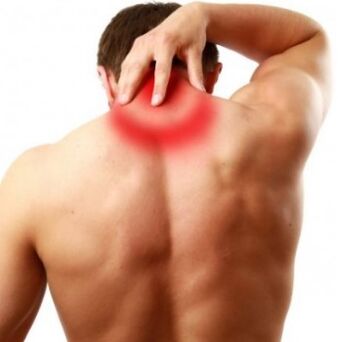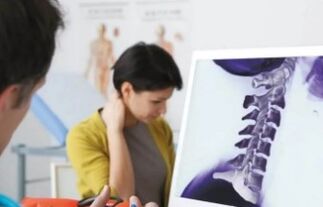Osteochondrosis is a spine disease, characterized by the development of changes in the cartilage of intervertebral discs and reactive processes in surrounding tissues.
Cervical osteochondrosis spineIt differs in its manifestations of thoracic and lumbar osteochondosis.Symptoms of cervical osteochondosis are associated with anatomical characteristics of the cervical column.The dimensions of the vertebrae in the cervical region are lower than the size of the other departments.The cervical service is constantly undergoing a charge, holds its head, and at the same time, it is a very mobility mobility.

The causes of osteochondrosis
The causes of the development of the disease, first of all, are due to aging linked to the age of the body and to the destruction in development of bone and cartilage.The following causes of osteochondrosis can also be called:
- Posture violation,
- Reduce motor activity following a sedentary lifestyle,
- An excess weight, which is the result of metabolic disorders, has a charge on the intervertebral discs,
- hereditary factor,
- Long -term physical activity,
- Anomalies of the spine.
Uniform physical activity, appropriate nutrition and a healthy lifestyle considerably reduce the probability of developing this disease, and also reducing the effect on the overall well.
Symptoms of cervical column osteochondosis
The manifestations of cervical osteochondosis differ from symptoms of the spine.This is due to the fact that the cervical vertebrae have a different structure and are very close.Therefore, any movement manifests itself in intense pain.In addition, a nervous beam and arteries are often pinched in the cervical column.
Cervical osteochondrosis of the spineIt manifests itself in the following symptoms:
- Pain sensations - Pain can be felt in different parts of the body.This is due to the fact that the nervous endings and the muscles of the corresponding part of the body.
- Weakness in the upper limbs-manifest himself due to the pinch of the nerve endings responsible for motor activity.
- Difficulty turning your head, the emergence of a crunchy vertebrae in the cervical region due to changes in the structure of the intervertebral disc, the appearance of bone formations.
- Low hands sensitivity.
- Weakness and dizziness appear due to the pinch of the artery, which ensures blood and nutrition in the brain.
- The reduction of hearing and vision - appears in the last stage of the disease, when the blood circulation in the cerebellum is disturbed.
Signs of the cervical service of osteochondrosis
- Rine syndrome - Characterized by a pinch of the nervous beam in the neck.It manifests itself in intense pain that can be felt in the shoulders, the spatula.
- Vertebrates syndrome - manifested by the strongest headaches, pain in the temples and the back of the head.
- Reflex syndrome - characterized by intense pain in the cervical region, which can intensify with any head movement.The pain can move towards the shoulder and on the chest.
- Cardinal syndrome - looks like an attack on angina, which is extremely difficult to determine.
The degree of development of osteochondosis of the cervical column
As it develops, the disease has passed several stages.Each step has its own characteristics and is characterized by certain characteristics.
- 1st step.Bone bone chrysny tissue of vertebrae is gradually starting to collapse.Symptoms of the disease are not perceptible.And very often, patients do not notice them, but associate fatigue and overwork and stress pain.
- STEP 2. In height, the disc starts to decrease, the cracks appear there.The patient experiences constant pain, weakness, numbness of the face.
- STEP 3. Disc drops begin to form, the cervical vessels and the muscles are damaged.There are complaints regarding dizziness, pain in the back of the head.
- 4th step.The bone tissue that protects the vertebrae from excessive load begins to grow, as a result of which the nerve endings are pinched.There is rigidity in the movements, the neighboring joints are damaged.
The dangers of cervical osteochondosis
A large number of nerves and arteries are located in the cervical region, which provide brain nutrition.In the event of a violation of their work, the brain will not receive sufficient nutrition for normal functioning.This situation can violate the motor activity of a person, cause pain in the members, as well as the loss of coordination.
In an advanced stadium of osteochondrosis, ischemia, strokes and many other dangerous diseases for human life can develop.
Therefore, when symptoms associated with this disease appear, it is recommended to request medical help.
Diagnosis of the cervical column
The following types of diagnostics are used to examine vertebral diseases:
- The x-ray image is an ineffective means of diagnosing this disease,
- MRI (magnetic resonance imaging) shows bone structures, hernia disks formed and their sizes,
- TDM (CT scan) is ineffective compared to MRI, because with the help of this diagnostic method, it is difficult to determine the sizes of hernias,
- Ultrasonic duplex scanning is used when total blood flow is disrupted.This examination shows the existing speed of blood flow, as well as the presence of barriers on its way.
Treatment of cervical column osteochondrosis

Treatment of cervical osteochondosis of the spine must be carried out in the complex according to the situation.A positive effect can be made thanks to a complete and individual approach, which includes drug treatment, physio of the procedure, physiotherapy exercises, massage and traditional medicine are also used.
During the aggravation period, the treatment of cervical osteochondosis of the spine aims to increase blood circulation, to get rid of muscle cramps.In this case, agents that improve blood circulation, anti-inflammatory and pain relievers and the vitamin complex are prescribed.
Media physical education for osteochondrosis in the cervical region
Therapeutic gymnastics gives visible results and is less dangerous at the recovery stage.The principle of action of physiotherapy exercises is to restore blood flow on damaged parts of the body.Perform physiotherapy exercise exercises, the patient should not feel pain and disadvantages.
All the exercises for the cervical column are designed to strengthen neck muscles, and also acts as a prevention of the development of cervical osteochondosis.
Massage for osteochondrosis of the cervical column
The massage is done to strengthen the tone of the muscles and relieve pain.Depending on the stage of disease development, different massage methods are made.Classic massage techniques include:
- Coutr - This technique consists of the effect on the surface layers of the skin.The massage begins with a necklace and continues clavicula and armpits.
- SOUTE - In this case, the effect during massage occurs on the deeper layers of the skin.Stick the neck with the thumb and index make movements to capture the skin, which resembles compression.
- Rub - carried out in order to warm and relax the skin to improve blood supply in the zone of the cervical column.
- DIFFUSION - has special restrictions because it affects deeply lies.If this technique is incorrectly carried out, the patient can be harmful.
In cases where the patient's pain feeling only occurs on one side, massage should start to occur from the healthy part of the neck, gradually moving to this part of the cervical region where pain appears.
Massage can be done at home and in a medical institution.However, when it is implemented, you must be very careful so as not to cause an exacerbation of the disease or not to do worse.
Prevention of cervical osteochondrosis
To avoid the occurrence and the development of the disease, it is recommended to comply with the simple rules:
- Carry out a healthy lifestyle, perform physical exercises, regularly visit the swimming pool;
- Diversify the diet rich in magnesium and calcium;
- In the case of sedentary work, it is necessary to warm up several times a day;
- For sleep, you must choose an orthopedic mattress and a comfortable pillow.






















